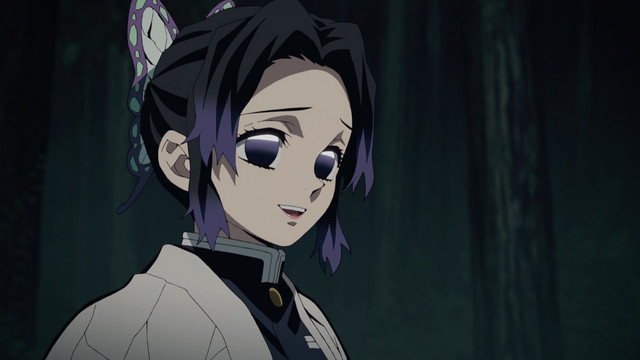
Since they’re primarily targeted towards boys, shonen battle anime tend not to have many female combatants. So having seen Haruo Sotozaki’s recently completed adaptation of Kimetsu no Yaiba spend its final arc with an entirely female fighting team came as quite a surprise.
We're of course referring to the demon slayers of the Butterfly Estate, which functions as a recovery base for injured slayers, but more importantly, as a dojo for the all-female practitioners of Insect Breathing. Breathing techniques are essentially Kimetsu no Yaiba’s anime fighting magic and the insect style is the only one seen so far that does not focus on winning through sheer force. It’s instead designed to help slayers with small bodies—like its creator, Shinobu Kocho—win with less raw power. It uses relatively light venom-coated weapons to inflict several small cuts that will poison its demonic targets, rather than cutting their heads off as is the win condition for all other schools of demon-slaying.
It might seem a bit condescending to depict the only female demon slayers seen in combat thus far as being so much physically weaker in a setting where victory is routinely achieved through shooting magic water that cuts people out of a sword. But believe it or not, the Butterfly slayers and their unique M.O. are both rooted in a fascinating but often overlooked facet of Japanese history, and we’re here today to tell you all about the kunoichi and how they influenced these demon slayers.
Kunoichi
Though modern media commonly depicts them as female ninja, historical kunoichi defined themselves by a skillset which though still centered on martial arts and espionage, emphasized their femininity to complete missions their male counterparts could not.
While ninja focused on being unseen and unheard, these women favored hiding in plain sight by entering their targets’ social circle under alias and spending weeks, months or even years as seemingly prim and proper model-civilians while spying on their neighbors, employers, and anyone else they needed information from.
Their strongest weapons were not swords, but their bodies, as they were taught to use their beauty and femininity to lure male targets without having to resort to violence. In fact, kunoichi had such little need to bear arms that the most they ever carried were light weapons that could be comfortably concealed in their kimono. Some didn’t even need to be hidden, like sharp hairclips coated in venom so deadly they could kill in a single scratch, or paper fans sprinkled with poisonous powder that would kill by simply waving it at the target.
Shinobu the shinobi?
You’ve probably noticed quite a few similarities between the ladies of the Butterfly Estate and the kunoichi, but let’s take a closer look at the aforementioned Shinobu Kocho and see how this powerful demon slayer mirrors her historical inspiration.
We first see Shinobu in action during the Natagumo Mountain arc, where she appears behind the elder sister spider demon without the latter noticing her presence, which establishes her talent in stealth at the start of the encounter. Although this is a skill more commonly associated with ninja in Japanese media, Shinobu’s feminine outfit and body language set her apart from their masculine iconography. A brief scuffle follows, which Shinobu interrupts by making a proposition of friendship to her opponent, presenting the kunoichi tactic of befriending one’s target to the audience. When the demon doesn’t accept Shinobu’s rather gruesome terms for friendship, the young slayer unleashes her Butterfly Dance breathing technique, which consists of rabid stabs using her poison-tipped sword, the same killing method used by the kunoichi.
The way the insect breathing demon slayer’s methodology mirrors the approach of kunoichi is enough to invite comparison on its own, but also worth noting is the fact that Shinobu’s demeanor does not change at any point in the fight. No matter what happens, she remains quiet, cheerful and polite, all the qualities of the idealized high-class woman of feudal Japan, as in the exact type of woman a kunoichi would have to act like. Since the kunoichi would spy and assassinate high ranking officials, they needed to be able to perfectly imitate high-class women, or at least high-class female servants by constantly reproducing behavior such as this, just like Shinobu, who has the same attitude whether she’s dealing with demons, demon slayers or anybody else. And just like with the kunoichi, this is a learned behavior, as we see a younger Shinobu act with nothing but bold aggression in a flashback where she’s under the tutelage of her mentor and older sister Kanae who carries herself exactly like Shinobu in the present—and consequently—exactly like a good kunoichi.
Final Thoughts
Although discrepancies between kunoichi and the butterfly demon slayers do exist, like their choice of weapon and propensity for direct confrontation, they’re far outweighed by the strong parallels these women warriors share. We hope you enjoyed learning about these slayers’ real-life counterparts and look forward to seeing more of these inspired characters when Kimetsu no Yaiba returns for the Demon Train Arc.


